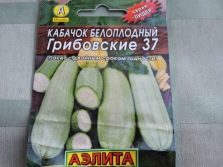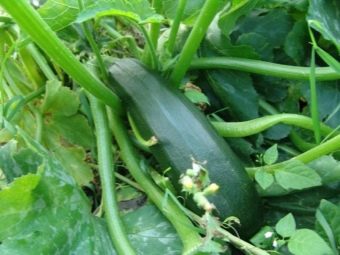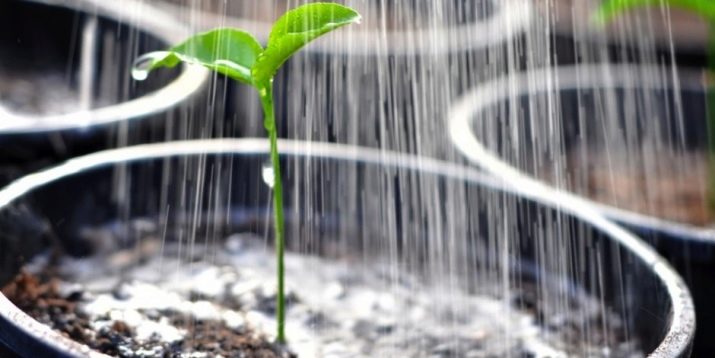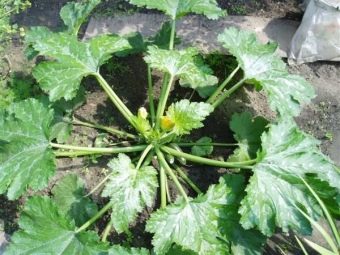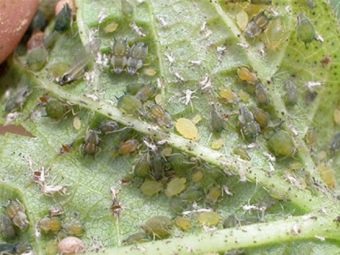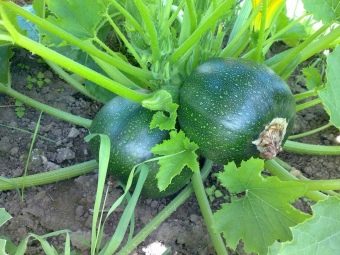When and how to plant squash for seedlings?
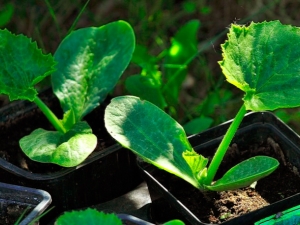
When it comes time to work for gardeners, many people think about how to plant seedlings right after all. On the packaging most often write recommendations for open ground. It is necessary to get acquainted with all the subtleties of the preparation and cultivation of seedlings of zucchini.
Preparatory stage
This stage is necessary for obtaining a good and numerous harvest in the future. There are various ways to sow squash for seedlings and grow crops in the shortest possible time. It is advisable to dig deep enough and additionally feed. Seedlings of zucchini can withstand small frosts, but if it is frozen, it most likely will not survive, while the seedlings look twisted and dark in color.
Soil preparation
Both for seedlings, and for an open ground the soil before landing of vegetable marrows is necessary for improving. For this perfect peat and humus, old sawdust and sod land. In addition, you can add a small amount of saltpeter.
The choice of fertilizer for the site depends on the type of soil, namely:
- if peat prevails in the soil, then it is necessary to add peat or humus (2 kg per 1 sq. m), clay soil (1 bucket), superphosphate (1 tsp), potassium sulphate (1 tsp) and furnace ash (2 tablespoons);
- if loamy soil prevails, then humus, peat and sawdust should be introduced in approximately 2-3 kg of each component;
- for sandy soil it is necessary to add sod land, peat (bucket per 1 sq. m), humus and sawdust (4 kg per 1 sq. m);
- for chernozem, you can add wood ash (2 tbsp per 1 sq. m), stale sawdust (2 kg per 1 sq. m.) and superphosphate (1 tbsp. l.).
Important: if you do not plan to plant a lot of zucchini, you should buy ready-made land in the store.
Agronomists advise to decontaminate the prepared soil with a solution of potassium permanganate, and also to disinfect the soil, it can be ignited in an oven at maximum temperature. It is necessary to freeze the soil from your plot in the summer to the next year, and when the time comes to use it, it must be heated. Thus, it will be possible to get rid of pests living in the soil. If the soil is purchased, then most likely it is ready for use. But be careful, manufacturers could add weed herbicides to the ground. In the soil with such a composition, the seeds may not ascend or will grow very poorly. In containers, the soil should not reach about one centimeter to the upper edge.
Seed selection
You need to decide how soon you want to harvest, on the basis of this is to choose early, mid-season and late varieties. For Russian climatic conditions suitable domestic varieties of zucchini. Imported more thermophilic, so when the temperature drops, they bear less. One should choose varieties of zucchini corresponding to the climatic zone, then it will be possible to avoid a number of problems with their cultivation.
There are the following types:
- ordinary zucchini - their seeds can be left for the next year, they have a denser fruit pulp, hard skin;
- Zucchini is small sunflower seeds, high-yielding, characterized by tender fruit pulp, young squash skin is soft, long stored due to the dense skins.
Important: the differences in taste of ordinary squash and zucchini are not particularly noticeable, therefore, when choosing seeds it is necessary to pay attention to other parameters.
The best early grades include the following:
- "Tsukesha" - this variety does not require seedlings, as zucchini is planted, the young fruits are dark green in color; have a length of 30–40 cm, weight reaches 900 g;
- "White Swan" - fruits are medium-sized, white; their weight is up to 800 g, they are stored for a long time;
- "Zebra" suitable for both open and closed ground, planting with the help of zucchini, fruits are represented in light green with dark green stripes, fruit length - up to 20 cm, weight - up to 1 kg;
- "Gribovskie 37" - this is a medium early, unpretentious variety that bears fruits well, light green fruits reach a length of 25 cm, and weight is up to 0.9 kg;
- "Golden" characterized by small orange fruits; length up to 10 cm, weight - up to 0.5 kg, this variety is good for salting;
- "Roller" - this is an unpretentious, ultra early ripening variety that bears fruit well, is resistant to low temperatures, and requires seedlings; white fruits have a mass of up to 1.3 kg and reach a length of 20 cm;
- "Helena" - disembarking occurs with the help of zucchini, golden-colored fruits have a weight of up to 900 g, in length - up to 22 cm, resistant to diseases;
- "Skvorushka" has dark green fruits with white specks, reaches a length of up to 25 cm, weight is up to 1.2 kg, can be used raw;
- "Waterfall" has small green fruits, medium in size and weighing up to 0.5 kg;
Among mid-season varieties, the following should be highlighted:
- "Nephritis" - This is a high-yielding variety, which is planted in open ground or seedlings, green fruits reach a length of 30 cm, weighing up to 1.2 kg; characterized by resistance to cooling;
- "Black handsome" it has a beautiful appearance, the fruits of dark green color reach up to 22 cm in length, their weight is up to 1 kg;
- "Pasta" - this is a mid-late variety, fruits of creamy-yellow color have a length of 20 cm and a weight of up to 1.3 kg; It is used for very tasty vegetable "pasta".
To the late varieties belong the following:
- "Long Fruit" - pale green fruits have a thin skin, up to 50 cm long and weighing up to 1.7 kg; This grade is recommended for an open ground;
- "Walnut" - this is a mid-late variety, beige fruits are up to 22 cm in length and weigh up to 1.5 kg, the shape of the fruit is pear-shaped; It is frost resistant.
How to plant seeds?
Seeds planted in open ground seedlings are more resistant and take root more easily.
Planting zucchini seeds includes several stages.
- Seedlings should be planted on seedlings from mid-March to mid-May. A month later, seedlings can already be planted. In open ground, seedlings or seeds are planted from the second half of May to mid-June. For planting seeds in open ground it is necessary to form the wells. Between the holes there should be a sufficient distance for the growth of zucchini in the future - approximately 70 cm.
- Seed preparation. Before planting, homemade seeds are neutralized. First, you need to withstand the seeds for 5 hours in water at a temperature of +50 degrees, and then harden them in cold water for about two minutes. And also it is necessary to disinfect the seeds with a solution of potassium permanganate. Further, in order for the seeds to germinate, it is necessary to hold them in a damp gauze until sprouts appear. Should ensure that the seeds are not dried.
- The choice of capacity. It is recommended to use a separate cup for each grain. And you can also plant several pieces and get rid of a weaker plant in the future. The soil in the containers should be disinfected with a weak potassium permanganate solution or hot water. Seeds that have already sprouted should be planted in pits up to 3 cm in depth by sprout. It is necessary to determine the pots in a bright place, where the temperature is about 5–7 degrees warmer than room temperature.
- Landing site. It should be chosen for planting seedlings or seeds of the area on which the sun shines most of the day. Squashes do not like, when in the past season, representatives of this family grew in their place (melons, cucumbers, pumpkin), as well as tomatoes, carrots and cabbage of late varieties. It is better that the precursors be plants of the legume family, onions or garlic.
Care
Seedlings should be watered with water at room temperature. It is important that the soil is moderately wet, but without stagnant water. You need to follow the top layer so that it does not dry out. No need to loosen the land in which the seedlings grow. After a good sprout begins to appear, the soil must be fertilized.To do this, perfectly suited solution of mullein or special fertilizers to stimulate growth. Seedlings loosening is not required, but the bed should always be loose.
Adult plants are watered with warm water every 10 days. Before the formation of ovaries, as well as before harvesting, watering should be stopped for a while. In some cases, you have to pollinate plants manually. During the flowering and fruit growth it is necessary to feed the plants. With this a great solution of mullein.
Possible problems
Fungal diseases
If the soil or seeds before planting are not sufficiently decontaminated, you should constantly inspect the plants so that the process does not spread, and you should also prevent the emergence of weeds.
Often there are fungal diseases such as:
- powdery mildew - manifested by white bloom on the leaves, most often affected old leaves; nitrogen fertilizers contribute to the spread of the disease, it is necessary to get rid of the affected leaves;
- white rot - all plant and fruits are covered with white scurf and rot, cold weather and frequent watering with cold water contribute to the development of the disease; need to remove the leaves with infection.
Viral diseases
Viruses infect only the plants themselves, while the seeds remain non-infectious. Viruses survive well in the soil, so the soil will have to replace and destroy the plants.
The most common viral diseases are as follows:
- green mottled mosaic - after the appearance of yellow-green spots the sheet is folded;
- white mosaic is characterized by the appearance of whitish spots on the leaves, resembling stars.
Pests
Zucchini pests often attack. Insecticides are used to combat them, and prevention measures should be followed (regular weeding, home herbal infusions).
Among the pests zucchini is the following:
- gourd aphid - these insects are localized under the leaves, sucking sap from plants;
- sprout fly strikes zucchini sprouts, and its larvae are transferred with manure.
Other problems
It is worth paying attention to the most common problems associated with the cultivation of zucchini.
- Pulling seedlings into growth may occur due to lack of sunlight or improper temperature conditions at night. It is important not to miss the moment when you can still fix everything, because such seedlings will not be able to develop. Too early planting of seeds or lateness with transplant of zucchini may also affect growth.
If such a problem arises, then it is worth adhering to the following algorithm:
- it is necessary to try to transfer the plants to another place where there will be enough sun, and also it is possible to transplant the zucchini into the boxes so that they have enough free space, as thick shoots cast a shadow over each other;
- If you use a lot of nitrogen fertilizer, you should reduce the number of dressings and less often water the seedlings.
- Spherical fruits. If spherical fruits have appeared, the potassium is not enough for the plant. This is corrected by adding wood ash or special fertilizers.
- Ovaries are not formed, which occurs due to bad weather. It is necessary to correct manually.
- Hype pumping by pumping crops occurs when the unsuitable crops are located close to the zucchini, which reduces crop yields.
- If it is cold outside, you will have to warm the plants. For this you should use a plastic film.
- Leaves curled. There are several reasons for this phenomenon. Some of them have been described above. In addition to them, the leaves can also curl due to improper care for zucchini. Frequent watering, insufficient amount of nitrogen - this adversely affects the plant.
- Seedlings have not risen. Most likely, the seeds were expired. Such seedlings will have to peresyat. To avoid this problem in the future, it is necessary to germinate the seeds before planting.
- Shoots appeared, but began to disappear.
There are several reasons for this problem:
- plants do not have enough moisture - transplant the remaining seedlings into a new soil or plant new seedlings;
- plants a lot of moisture - you need to check the drainage hole;
- seedlings are affected by root rot - the remaining plants should be transplanted into another soil, washing the roots in a solution of potassium permanganate;
- seedlings became infected with a black leg - as soon as this disease is noticed, you need to water the plants with a solution of potassium permanganate; and it is recommended to ventilate the room in which they are located;
- soil acidity is not suitable for plants - it must be neutral; increase the acidic environment can be a solution of lime;
- attacked pest - is to spray and water the seedlings "Karbofos."
- The transplanted senets no longer grow. This means that zucchini has a weak root system. It is possible that during the transplantation it was damaged or the roots were bent incorrectly. You should water the pots before transplanting. If there is space left around the roots, it is worthwhile to fill the grooves during water transplantation and bury the roots in such pits.
- If the seedlings do not grow further, then this may be for the following reasons:
- corking the roots - the soil should be treated with “Fitosporin”;
- peat is not suitable for seedlings.
- If the leaves are hard, then the plants do not have enough water or a lot of fertilizer. It should be washed with water, if there is confidence that it will easily drain. And the reason may be a small amount of nutrients, especially nitrogen, which occurs most often due to excess moisture. It is necessary to do fertilizing urea.
It is important: in a timely manner to make additional feeding, but not to overdo it with them.
When can be planted in open ground?
Seeds in open ground can be planted at a steady-state temperature, when frosts are no longer expected. Seedlings zucchini pretty quickly freezes. For the harvest to please for a long time, you should plant seeds at intervals of one to two weeks. Plants are planted in late May or early June. It is important that the seedlings were already about a month. Squashes before planting in open ground need to be hardened. To do this, they need to be taken out for the day on the street, and cleaned up for a night in a warm place.
Growing zucchini tricky way is shown in the following video.








